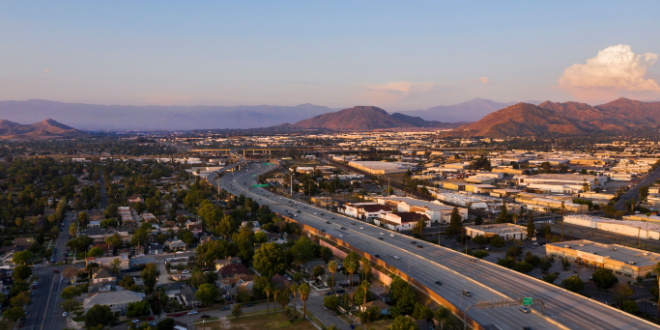When he was a student at Alta Loma High School, Brian Bush took drafting classes and planned to be an architect.
Then he watched the construction of Colonies Crossroads, a 447-acre master planned community next to the Foothill Freeway in Upland and changed his mind.
“I grew up in Alta Loma and the Colonies was being developed near my house.” said Bush, who graduated from Alta Loma High School in 2005. “Watching that is what got me interested in development. They took an underutilized piece of property and turned into a flagship property, and that inspired me to pursue real estate development as my career.”
“Back then, I thought the architects controlled the development. Later I learned it was the developers who took the lead.”
Shortly thereafter, Brian worked and became friends with many of the members at Red Hill Country Club in Rancho Cucamonga, where Jeff Burum, the developer of Crossroads Colonies, was a member.
“They all steered me in the direction of Jeff. It took a while, but I finally was able to meet with him about the time I turned 18.”
Burum became a mentor to Brian. Brian started his career in development at National Community Renaissance (CORE), a non-profit affordable housing developer based in Rancho Cucamonga, CA, which Burum founded in 1991. Working full time and going to school, Burum assisted with his tuition at Cal Poly Pomona, where he earned a Bachelor of Science degree in Urban and Regional Planning.
“I was 19 when I went to work at CORE,” Bush recalled. “l learned the whole gamut of housing development, working on financial analysis, entitlements, CTCAC applications, land development and construction.”
After working with CORE for 3 years, in 2009 he joined Diversified Pacific, Burum’s homebuilding company. Today, Brian is a vital component of the company and serves as the company’s Vice President of Acquisitions.
“Being in acquisitions, I may be more optimistic than others,” Brian said. “I really believe the housing market will continue to be robust in 2024.”
 Brian spoke recently with IE Business Daily on a range of topics, including the state of the housing market and how to build more homes locally and statewide. This interview has been edited lightly for clarity.
Brian spoke recently with IE Business Daily on a range of topics, including the state of the housing market and how to build more homes locally and statewide. This interview has been edited lightly for clarity.
Question: Can we talk about the state of the housing market, first in California and then in the Inland Empire?
Answer: Right now, California has an affordability and a supply issue. Demand is especially high in the Inland Empire because it is a more affordable market. That’s how the Inland Empire’s growth has occurred. It is a bedroom community of Los Angeles and Orange County, and a more affordable option, even though the majority of the jobs were located in Los Angeles and Orange County.
Q: That hasn’t changed?
A: To a certain extent. However, even though the Inland Empire remains a more affordable option compared to other areas of the state, it has flourished more than many other major metro areas. The Inland Empire is now an economic powerhouse. As a result, I see strong demand for housing continuing for the foreseeable future.
Q: Recently you participated in a panel discussion sponsored by the Greater Riverside Chamber of Commerce regarding housing in Riverside. You talked about cities using housing as a tool for economic development. Can you talk about that?
A: Housing creates jobs and property tax revenue. When you add new rooftops, it stimulates commercial and retail development, which generates sales tax revenue. Unfortunately, the Inland Empire loses significant sales tax revenue to adjacent counties because we lack the “cool factor.” We don’t have the Pacific City (Huntington Beach) or Americana at Brand (Glendale) or LA Live (downtown LA), we have only a handful of lifestyle/entertainment centers. When appropriately designed, housing can be used as the foundation to support these lifestyle hubs. That’s how it can be used as an economic driver, creating substantial economic impact on any city.
Q: How well would that work in the Inland Empire, which is very large and spread out?
A: It would do very well. For example, if Ontario International Airport offered the same flights as LAX, do you think people in the Inland Empire would prefer LAX or Ontario? However, the Inland Empire doesn’t have a flagship, or a home base. There’s no real central area to the Inland Empire. I think Ontario, Rancho Cucamonga, Riverside and Temecula are the closest things to that, and all can be so much more. Ontario has land and an international airport, which is why [Diversified Pacific] is investing in Ontario. We are planning a 600-room luxury hotel near the airport and convention center. Developments such as our luxury hotel are flagship projects that will be catalysts for growth. Growth the Inland Empire has never experienced but will.
Q: Hasn’t residential always attracted retail?
A: Yes, but to date it includes traditional shopping centers and malls. People here go to Los Angeles or Orange County if they want an experience. They have lifestyle centers and entertainment that draw people away from the Inland Empire because it offers little in the way of “experience venues.” There are Victoria Gardens in Rancho Cucamonga and the Mission Inn downtown area in Riverside and that’s about it.
Q: Is it possible to overcome that?
A: Yes. We have land. I can see Ontario Mills and even Victoria Gardens redeveloped into more than they are today. Malls in general will change. They won’t be surrounded by parking lots like they are now. They will have parking structures, more high density residential and a mix of uses. The Inland Empire can take advantage of these opportunities, especially when cities join in this shared vision.
Q: People aren’t used to parking structures. If your prediction is correct, how will they react to it?
A: It’s already coming to that. Several areas of the Inland Empire have parking structures and we’re seeing them more on wrap parking for new apartment developments. When they are designed right, they are much more appealing than a sea of surface level parking.
Q: During the panel discussion, you called housing a business priority. What did you mean by that?
A: It’s a business priority and it’s abundantly clear through review of the Regional Housing Needs Assessment (RHNA). Every city and county in our region were allocated its share of housing units that they must plan for or risk losing control and/or funding. Many of our local jurisdictions were forced to rezone properties to accommodate these units and stay in compliance. Although most jurisdictions in our region are complying, the goal of actually delivering these units to the market is far behind. We simply cannot entitle and build fast enough.
Q: Why do you think it’s been so difficult to do?
A: One problem is a lack of developers. Since 2005, the development community has dwindled. Some developers have changed business plans, removing California entirely for future projects. The main deterrent is that it is simply too difficult and lengthy to process entitlements in California. Then when you add high interest rates and construction costs, the red tape and risk feel overwhelming.
Q: Why is it so important to mix housing with lifestyle centers?
A: When housing is a component of lifestyle centers, like they’ve done at Americana at Brand in Glendale, it establishes a user base for the lifestyle centers. When people live in high density, they want to be able to work and play there too. Lifestyle centers provide residents with a more walkable environment.
Q: I think everyone agrees that housing prices in California are too high. What can be done?
A: Working together to find solutions is the start. High material costs, infrastructure costs and fees are some of the most notable causes that lead to high pricing, along with lack of supply. We are simply not producing enough housing, causing the current demand to push pricing. As for actual costs, lack of infrastructure has caused many projects to stall, further hurting the supply chain. More staffing at an agency and city level would help expedite processing. As for infrastructure, we need agencies and the development community to be more forward looking to prevent delays in growth and new opportunities. New development will spur economic growth and fuel revenue growth in each city. The key is the cities need to participate financially with this future growth and the compensation will be new taxes generated within the cities.
Q: The city would get its money back, over time, in the form of more property tax revenue?
A: Yes, and more sales tax revenue. That’s another example of housing as an economic driver. If you develop more housing in downtown Riverside, which is what they’re planning to do, the people that live there are more likely to shop there.
Q: How do you expect the housing market to perform in 2024?
A: I think the Inland Empire housing market will be similar to 2023. Right now, we are seeing interest rates gradually coming down, which should move some buyers off the sidelines. And it may also stimulate growth and activity in the multifamily and other commercial sectors. The cities that issue the most housing permits will be those that have a streamlined permitting process and adequate infrastructure for the new housing units.
Q: Depending on the jurisdiction, how difficult is it to get a project approved?
A: On a scale of 1 to 10, with 10 being the most difficult, I would rank most jurisdictions in Southern California a 9, with the Inland Empire no exception. For example, a large master planned community will now likely take more than 10 years before a shovel is in the ground. That’s just too long.
Q: Ideally, how long would it take for a development to start construction?
A: Six to twelve months from first submittal to recorded final map for a traditional 100 lot subdivision. This was the time required 20 years ago. Today, this approval and permitting process will require 24-30 months or more from formal submittal to grading permits. How will we ever achieve our required RHNA numbers in this environment? The process and procedures need to improve drastically, and soon. When will we proactively provide housing for our growing population? When it once again becomes a priority and not considered a burden.
Q: What else would help the permitting/streamlining process?
A: First, at the initiation of the planning process, let’s create a measurable process to easily identify and work to tackle the hurdles and requirements. Provide developers with assurance of the beginning to end time limits for approvals. There must be an inherent confidence that the process will result in success. Measurable both in terms of time and costs. For conventional single-family communities, the process is bifurcated into two phases, entitlements, and final engineering. If developers can become more confident that the proposed entitlements will be approved, they are more likely to commence work on final engineering, saving months.
A primary hurdle in these processes in the past decade has been environmental approvals. Environmental permits are typically processed after the entitlements are approved and may take years to secure. When city’s General Plan the future of their respective jurisdiction they should absolutely include environmental support for their plans, which the developer can then access as support in their individual planning and permitting process. This would save months and sometimes years, along with thousands, if not millions of dollars when this process is streamlined.
Q: The panel discussion dealt exclusively with Riverside. What is your assessment of how they’re handling their housing issues, particularly their RHNA requirements?
A: Riverside is taking a proactive approach, which needs to occur in every city in the Inland Empire. Second only to the city of Ontario, Riverside received the highest allocation of housing units in the Inland Empire. This is a monumental effort, and they are taking the right steps forward to do everything they can to meet their goals. Riverside has taken a proactive and positive approach to delivering housing. They actively seek to engage with the development community. They are moving in a positive direction.
 IE Business Daily Business news for the Inland Empire.
IE Business Daily Business news for the Inland Empire.


